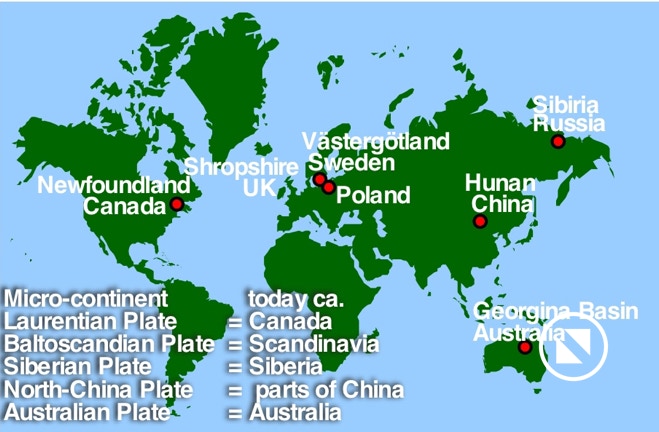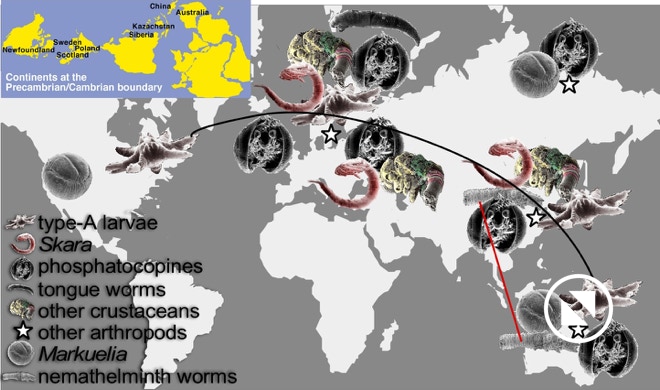'Orsten' on World-Wide Scale
When plotting the occurrence of different 'Orsten' fossils on a world map, it becomes evident that these reflect the continent situation in the Cambrian quite well. After the break-up of the large super continent Rodinia at the end of the Precambrian, a number of smaller continents lay like pearls along a line near the equator, north of the remaining Gondwana continent. Remarkably, no 'Orsten'-type fossils have been reported from the continental areas around Gondwana so far, though the so-called "small shellies" are numerous (more on these in due course; see, e.g. papers by O. Elicki). The zero record of 'Orsten'-type fossils from any of the coasts around the Gondwana continent requires further consideration.
The 8 localities from which Orsten fossils have become known so far are from 4 continents (only taxa mentioned with more than 1 record):
North America
- ▪ East. Canada: only type-A larvae so far
- ▪ Nevada, USA: uncertain record of embryonic stages of a nemathelminth worm called Markuelia
Europe
- ▪ Comley, England: phosphatocopine larvae so far
- ▪ Southern Sweden: the bulk of the material, incl. Agnostus pisiformis with limbs, e.g., type-A larvae, 2 Skara spp., eucrustaceans, and a microscopic lobopodian; only here: 1 chelicerate, soft parts of 1 Agnostus species, tongue worms and cyanobacterians
- ▪ Northwest Poland: 1 indet Skara, phosphatocopines
Siberia
- ▪ Olenek uplift: phosphatocopines, Markuelia, a tardigrade
China
- ▪ Guizhou: Lower to Upper Cambrian forms, incl. phosphatocopines, Skara huanensis and other eucrustaceans, nemathelminths, Markuelia, unpublished tardigrade and a microscopic lobopodian
Australia
- ▪ Georgina Basin: nemathelminths, phosphatocopines, type-A larvae, 1 fragment of a putative marrellid (Arthropoda s. str. incertae sedis).
Apparently faunal connections existed between the micro-continents. The widest distribution and the longest geological record have, remarkably, the tiny type-A larvae, the oldest record of true (eucrustacean) nauplii. They were found in from almost all regions, the Laurentian shield and Baltica/Europe to China and Australia, preferentially occurring in the Cambrian series 3, but with a range from Middle Cambrian to the Furongian (formerly Middle to late Cambrian), possibly even lower Ordovician. Other forms were less widely distributed, but their occurrence hints at two major connections (besides the overall connection):
- ▪ one between Europe, Siberia, and China (eucrustaceans incl. Skara), with extensions to Australia (phosphatocopines, pref. from Cambrian series 2 and 3, but Klausmuelleria from Comley, England possibly from the Terreneuvian [series 1], formerly lower Cambrian; 3D preserved phosphatocopine shields occur also in samples from Siberia, possibly series 2, but are all squeezed, soft parts lacking, phosphatocopines from possibly series 2),
- ▪ one between China and Australia (nemathelminths, excl. the embryonic Markuelia, which may be owed to the proximity of the micro-continents.
The overall distribution along the coast of the mentioned micro-continents is also reflected by wide distribution of phosphatocopines, but the Australian forms seems to have no apparent systematic connection to those of series 3 and Furongian faunas not least because their appendages are lacking exopods; only the recently described species from Poland also lacks exopods, but it is much younger and closely allied to the Swedish hesslandonids. The connection of the continents is, furthermore, indicated by the yet by finds of Markuelia in Siberia and an uncertain occurrence on the North-American continent (Nevada).
Species recognized as derivatives of the stem lineage to Crustacea were reported so far only from Sweden (all upper middle Cambrian). The eucrustacean Skara was reported from Europe and China, with a geological range from the upper middle Cambrian (Sweden, Poland) to the Furongian (China). Other species assigned to Eucrustacea are also known only from Sweden (upper middle Cambrian to late Furongian) and China so far, but there from the Lower Cambrian. Again, micro-lobopodian "stem" arthropods (Arthropoda s. l.) in 3D preservation are known only from Sweden (1 species) and China (unpublished). Yet, their macroscopic counterparts have been reported in flat preservation from the North America to northern Greenland (Hadranax augustus, see Budd & Peel,1998), Europe (Xenusion auerswaldae) and China (>10 species). Considering also certain micro-fossils called Microdictyon in small-shelly assemblages around the globe, which could be identified as plated cuticular elements of lobopodians, the range of lobopodians must be apparently much wider. Water bears or tardigrades, another "stem"-arthropod group, are known from possibly series 2, formerly Middle Cambrian, of Siberia (still to be described taxonomically), but at least one unpublished specimen from China hints again at the strong connection between Siberia and China. The third group of stem-arthropods, tongue worms or Pentastomida, has been discovered, so far, only in Sweden, with a short geological range from the late Cambrian to the Lower Ordovician (Andres 1989). Remarkably, these do not occur together with any of the other arthropods, but only with tooth elements, conodonts, of conodontophorids, fish-like craniote euchordates ("not-yet" vertebrates). This might give some information on their occurrence and life strategies, and their long-lasting host/parasite association with craniotes – and NOT with arthropods (contrasting Siveter et al. 2105, depicting, in our view, a piece of dirt but not an animal).
Besides arthropods, there is only one more metazoan taxon preserved in 'Orsten' type 3D preservation, namely an in-group of roundworms, nemathelminths, called cycloneuralian (because of their ganglial nerve ring instead of a frontal pair of ganglia = no head developed). This in-group taxon possesses a chitin-bearing cuticle that has to be moulted, similar to the situation in arthropods, but in our view convergently evolved since other features are simply basal and do not go back to a common ancestor. Longer known are 2D preserved, cm long but slim so-called palaeoscolecids, worms with a cuticle made of numerous small, button-like plates. Isolated plates were described as Hadimopanella and others within "small shelly" assemblages (e.g. Hinz et al. 1990), long before the finds of pieces of the worms in 3D (Müller & Hinz 1993). If the records can be confirmed in the future, the embryonic form Markuelia, actually a late larva still inside the egg, it has a similarly wide distribution as the type-A larvae, and its geological record ranges from the Cambrian series 2 to the Lower Ordovician. Another tiny nemathelminth became known from the Cambrian series 2 from Australia, clearly an early larva, a number of other larvae known from their vase-like trunks, loricae, apparently a feature shared with the tiny Recent vase animals, loriciferans, and the priapulids, which range from being tiny to forms being more than 10 cm long. The missing record of even a fragment of such animals from the localities in Europe is striking and has no explanation yet. It also becomes clear that preservation of 'Orsten'-type fossils from different times may be caused by different reasons and are not necessarily from nodular limestones, as in Västergötland, Sweden. This will be investigated in more detail in the future.
Our still up-to-date joint paper about general aspects of the 'Orsten':
- ▪ Maas, A. Braun, A., Dong Xiping, Donoghue, P., Müller, K.J., Olempska, E., Repetski, J.E., Siveter, D.J., Stein, M. & Waloszek, D. 2006. The ‘Orsten’ – more than a Cambrian Konservat-Lagerstätte yielding exceptional preservation. Palaeoworld 15, 266-282.
References:
- ▪ Budd, G.E. & Peel, J. S. 1998. A new xenusiid lobopod from the Early Cambrian Sirius Passet Fauna of North Greenland. Palaeontology 41(6), 1201-1213.
- ▪ Hinz, I., Kraft, P., Mergl, M. & Müller, K.J. 1990. The problematic Hadimopanella, Kaimenella, Milaculum and Utahphospha identified as sclerites of Palaeoscolecida. Lethaia 23, 217-221.
- ▪ Müller, K.J. & Hinz-Schallreuter, I. 1993. Palaeoscolecid worms from the Middle Cambrian of Australia. Palaeontology 36(3), 549-592.
- ▪ Siveter, Da.J., Briggs, D.E.G., Siveter, De.J. & Sutton, M.D. 2015. A 425-million-year-old silurian pentastomid parasitic on ostracods. Current Biology 25, 1632–1637.
In this Section...
© 2020 CORE




